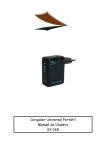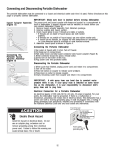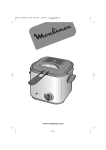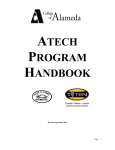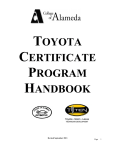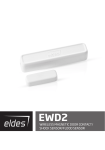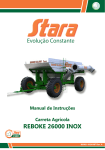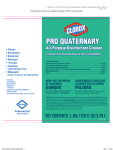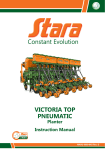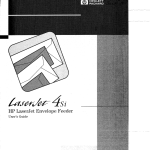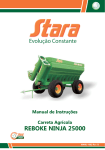Download Instructions Manual
Transcript
Edition 1 – Ver. 000 – May 1st, 2013 Edition 1 – Ver. 001 – June 10th, 2014 LEGAL ADVICE All of the information published in this manual is the property of Sitmed Equipamentos Médicos Ltda. Sitmed reserves all copyrights of the writing content, the insert images in our website and this manual, as well as the design, patents, manufacturing, distribution e sales of the equipment here presented. Sitmed authorizes the customers and users of its products to read and print this manual for instructional purposes Any use of this content by third parties, other than the above specified, will be allowed only with the Sitmed formal express consent and except when an image, product, part or accessory is the intellectual property of any customer or supplier. The Sitmed reserves the right at any time to make changes in content writing, the images on your website and in this manual, as well as the models presented. It is forbidden any use of this publication, in whole or in part, as well as copy pictures and written content without the written consent of Sitmed. Sitmed Equipamentos Médicos Ltda. (All Rights Reserved) Rua da Paz 1629, Nossa Senhora Aparecida – Flores da Cunha, RS – Brasil CEP: 95270-000 Fone / Fax: (0xx54) 3292-1024 E-mail: sac@sitmed.com.br Web Page www.sitmed.com.br Sumário LEGAL ADVICE............................................................................................................................................................................ 3 Safety Information.................................................................................................................. 6 WARNING GUIDELINES............................................................................................................................................................ 7 GENERAL INFORMATION........................................................................................................................................................ 7 LIABILITY LIMIT.......................................................................................................................................................................... 7 GUIDELINES FOR TRANSPORTATION OF PACKAGING.................................................................................................. 8 FIRST AID AND PRECAUTIONS FOR USE OF THE EQUIPMENT................................................................................... 9 SKILLS OF OPERATORS............................................................................................................................................................ 11 IMPORTANT NOTICES.............................................................................................................................................................. 11 Information About the Equipment................................................................................... 12 PIB 10..13 GENERAL FEATURES OF ......................................................................................................................................................... 14 SITMED EMERGENCY COTS.................................................................................................................................................... 14 General Features:..........................................................................................................................15 RESCUE CHAIR - CDB 53 MODEL.......................................................................................................................................... 15 RESCUE CHAIR LOCKING SYSTEM....................................................................................................................................... 16 (CDB 53 MODEL)........................................................................................................................................................................ 16 ESPECIFICAÇÕES....................................................................................................................................................................... 17 CDB 53..........................................................................................................................................17 MRB 30..........................................................................................................................................19 MWB 39........................................................................................................................................21 MXB 38..........................................................................................................................................23 PARTS AND ACCESSORIES PROVISION.............................................................................................................................. 25 Instructions for Use, Installation and Settings.............................................................. 27 ADJUSTMENTS OF HEIGHT OF WHEELS AIR.................................................................................................................... 28 (MODELS MRB 30 - MXB 38 - MWB 39).............................................................................................................................. 28 Components...................................................................................................................................29 FRONT LOCKING SYSTEM . .................................................................................................................................................... 29 (MODELS MRB 30 - MXB 38 - MWB 39).............................................................................................................................. 29 Components...................................................................................................................................30 CENTRAL LOCKING SYSTEM.................................................................................................................................................. 30 (MODELS MRB 30 - MXB 38 - MWB 39).............................................................................................................................. 30 TRAVA MACA X........................................................................................................................................................................... 31 Locking System Installation................................................................................................ 32 FRONTAL AND CENTRAL LOCKING SYSTEM INSTALLATION IN AMBULANCE...................................................... 33 (MRB 30 MODELS - MXB 38 - MWB 39).............................................................................................................................. 33 Cot’s Components................................................................................................................... 39 Mattres..........................................................................................................................................40 RESCUE COTS COMPONENTS AND ACCESSORIES......................................................................................................... 40 Safety Belts...................................................................................................................................42 Side Handles..................................................................................................................................46 Rear Handle . ................................................................................................................................47 Wheel Brake..................................................................................................................................48 Mobile Headboard (Backrest).....................................................................................................49 Using Stretcher Transport Sitmed..................................................................................... 51 SITMED RESCUE COT –MRB 30 MODEL (RETRACTILE)................................................52 LEGS RETRACTILE SYSTEM . .................................................................................................................................................. 52 SITMED RESCUE COT - MXB 38 MODEL (MULTI-LEVEL)...............................................54 SITMED RESCUE COT – MWB 39 MODEL........................................................................................................................... 56 (DOUBLE FOLDING LEGS)....................................................................................................................................................... 56 HOW TO PUT THE PATIENT OVER COT................................................................................................................................ 59 HOW TO RAISE THE COT.......................................................................................................................................................... 62 HOW TO MOVE THE COT......................................................................................................................................................... 64 USING ADDITIONAL HELP...................................................................................................................................................... 65 Inserting and Removing the Stretcher from the Ambulance................................. 66 HOW TO ENTER THE COT INTO THE AMBULANCE......................................................................................................... 67 REMOVING THE STRETCHER FROM THE AMBULANCE................................................................................................. 69 Maintenance............................................................................................................................. 71 PERIODIC INSPECTION AND MAINTENANCE OF EQUIPMENT.................................................................................. 72 COMPATIBILITY WITH OTHER SYSTEMS LOCK................................................................................................................. 73 CLEANING METHOD RECOMMENDED.............................................................................................................................. 73 EQUIPMENT DISCARD............................................................................................................................................................. 73 MRB 30 MODEL..........................................................................................................................74 MXB 38 MODEL..........................................................................................................................74 PROVIDING POTENTIAL INJURY LOCAL............................................................................................................................. 74 MWB 39 MODEL........................................................................................................................75 CDB 53 MODEL..........................................................................................................................75 Rescue Cot Model MRB 30 e MWB 39...................................................................................76 Rescue Cot Model MXB 38........................................................................................................76 Rescue Chair Model CDB 53......................................................................................................76 SERIAL NUMBER LOCATION................................................................................................................................................... 76 Warranty Certificate, Technical Support Service e Customer Service.................. 77 TECHNICAL SUPPORT SERVICE............................................................................................................................................ 78 CUSTOMER SERVICE................................................................................................................................................................. 78 WARRANTY CERTIFICATE........................................................................................................................................................ 78 1 Safety Information GENERAL INFORMATION This manual provides important information about the use of Sitmed Emergency Cots. Read it carefully and be aware of all the safety instructions, so then you can use the equipment properly and safely. All information presented in this manual were formulated in accordance with the standards and procedures of Good Manufacturing Practices. Sitmed Emergency Cots were developed for external use in pre-hospital environments. They’re practical, versatile, does not require special conditions for use and are used for the transport of disabled persons and victims of accidents. Specifically used in ambulances and mobile ICUs, being operated by paramedics which were trained in rescue operations and medical emergencies. LIABILITY LIMIT Sitmed isn’t liable for damages caused by: - Failure to observe the instructions in this manual - Use in disagreement with this manual - Natural wear of its components - Improper installation or use WARNING GUIDELINES The warnings in this manual are marked by symbols and specific words that determine the extent of its importance. WARNING Orientation which indicates a potentially hazardous situation which, if not avoided, could result in an injury to the patient or the operator. IMPORTANT: Advice that indicates a potentially hazardous situation, which if not avoided may result in property damage and accidents, from improper use of the equipment. NOTE: Indicates suggestions and recommendations as well as information for the correct and efficient use of the equipment. GUIDELINES FOR TRANSPORTATION OF PACKAGING The devices herein are delivered properly packed from the factory in order to ensure its integrity during shipping and storage. If you receive the equipment with damaged packaging, and immediately check in the presence of the carrier if the equipment has been damaged. If so, the damage must be reported and the merchandise must return to Sitmed. - Packaging shall be handled and transported with care, avoiding exposure to heat and humidity. - Packaging shall be transported as indicated by orientative arrows. - Note the maximum stacking and direction that the box must be transported and stored, as described on the package. - During transport, avoid mechanical shocks. - Properly inspect the equipment when it is received. IMPO RTANT! If are ascertained any problems, breakdowns or even in case of doubt, consult our Customer Service - Customer Service E-mail: sac@sitmed.com.br - Phone: +55 54 3292 1024 FIRST AID AND PRECAUTIONS FOR USE OF THE EQUIPMENT ATTENTION : An accident victim can only be transported once evaluated, stabilized and immobilized appropriately. First aid is the first care given to the victim in the situation of an accident or sudden illness. The role of the doctor, paramedic or first responder, is to keep the victim alive and avoid causing the so-called second trauma, in other words, cause other injury or not aggravate existing ones. The transport of victims involves serious risks if not taken basic measures and essential first aid, made by skilled professionals. The handling or transporting a victim must be done carefully, so as not to aggravate existing injuries or their vital status. Transport to the hospital must be performed by mobile ICU’s or equipped ambulances. Avoid transporting accident victims in other types of vehicles that are not prepared for this purpose. WARNING : Inappropriate transport may cause a second trauma or the death of the victim. Sitmed Emergency Cots are the best means of transporting injured or sick people, however, before providing their removal should be evaluated their vital and physiological conditions, as well as take the following basic steps when necessary: 1 Control if there is hemorrhage 2 Keep patient’s breathing 3 Immobilize all suspected points of fracture 4 Control or avoid any state of shock 5 Wear cervical collar, head immobilizer and immobilize the victim over a backboard. The procedure for immobilization and transport an accident victim, using the backboard, should include the following steps: 1 Always keep the victim’s body in a straight line 2 Avoid any body curvature 3 Roll the victim to the side, keeping the body straight 4 Enter the backboard forward the victim 5 Roll the victim back on board 6 Immobilize using cervical collar, spider belt and head immobilizer. Spider Belt Head Immobilizer Cervical Immobilizer Immobilization Board To transport accident victims safely over boards immobilization are required a minimum of two trained rescuers. If the patient is obese or ground conditions are unfavorable, you will need additional help from at least two other people. Rescue Nurse Rescue Nurse Immobilized Patient WARNING : Any accident victim carries spinal cord trauma until proven otherwise. IMPORTANT NOTICES - Inexperienced operators can hurt themselves and cause injury to the patient. The litter should be used only by trained health professionals. - Improper use and incorrect equipment can cause injury to the patient and the operator. Use only as described in this manual. - A patient without appropriate care may be at risk of life. Use the appropriate equipment and correctly. - A patient without immobilization may fall off the litter and cause an injure. Always use safety belts and the side handles of the cot to immobilize the patient and ensure their safety on the equipment. - Not maintaining a periodic maintenance or doing it incorrectly can cause accidents and improper use of the equipment. Make periodic maintenance as described in this manual. - Using spare parts from other manufacturers or inadequate, generates risk of accidents, improper use of equipment and establishes loss of warranty, and the consequent liability of the owner for damages. Use only original parts supplied by Sitmed and before servicing, please read this manual or contact our Technical Support to receive guidance and clarification. - Make any changes to the cots, altering its original design, creates the risk of accidents, improper use of equipment and establishes loss of warranty, and the consequent liability of the owner for damages. Before doing any repairs to the equipment please read this manual or contact our Technical Support to receive guidance and clarification. - Read carefully the instructions specified in this manual, before using any of the equipment here presented. - Before using any equipment, make sure that it is in perfect condition. - Regularly check the integrity of the equipment and check for damage or loose components in its structure. - Always store the equipment sanitized and in perfect condition for the next use. SKILLS OF OPERATORS To operate properly the cots and transport safely the patients, operators and first responders need to have: - Knowledge of emergency procedures and first aid. - Skill, calm and security to meet the patient or accident victim. - Read and understand all instructions in this manual. - Follow a training program conducted by a qualified coach. - Practice using the equipment and accessories before using them in real situations. 2 Information About the Equipment PIB 10 Designed for rescue and emergency situations. - Particular purpose for gathering, immobilization and transport of accident victims. - Dimensioned to withstand patients with up to 200Kg. - Anatomic design for better safety and patient accommodation. - Rigid, lightweight and comfortable. - Offers large and anatomical handles to facilitate manual transport. - Radio transparent for use in X-Ray devices. - Design for use in Magnetic Resonance rooms. - Have specific openings for spider belt immobilization. - Enables rescue on water and high altitudes. - Waterproof material, easy to clean and sterilize. - Assist help is necessary for high weight patients - Disinfection using alcohol or nonabrasive germicidal disinfectant. - Before using the equipment, read the instructions and specifications of the user manual. - Before using the equipment, make sure that it is in perfect condition. The presence of defects such as cracks and deformations may compromise the use of the equipment. PIB 10 Material Lenght Largura Thickness Net Weight Gross Weight Packaging Dimensions Package Volume Load Capacity Linear medium density polyethylene RD 34 U3 1830 mm 440 mm 65 mm 7,5 kg 9,0 kg 0,09 X 0,46 X 1,85 m 0,076 m³ 200 kg GENERAL FEATURES OF SITMED EMERGENCY COTS Sitmed Emergency Cots are versatile equipment for the transport of patients and accident victims in pre-hospital environments. Specially designed to reduce the effort at the moment to put them and remove from the inside of ambulances. Are mounted with light and resistant aluminum profiles, load bearing up to 300 kilograms. Have recoil system of the legs, adjustable backrest height mattress made with polyurethane foam covered in waterproof material, seatbelts and a complete lock system to adapt the ambulance. General Features: - Designed to reduce the effort to transport victims. - Structure in hard tubular aluminum. - Sized to withstand loads between 200 and 300 kg depending on model. - Adjustable backrest with six height positions. - Mattress sealed with electronic seam. - Coated with waterproof material, self-extinguishing and anti-mildew. - Available in light blue (other colors on request) - Four casters with 127 mm diameter brake system. - Tilting system side handles with automatic closing. - A four tips automotive belt with quick coupler system. - Two double tips security belt with quick coupler system. - Anchoring system for complete installation in rescue vehicles. - Can be produced in different heights, according to the vehicle to be installed. - Leg Folding System. - Automatic safety system that prevents accidental fall. NO TE: These devices are based on the following standards : ABNT NBR 14561/2000 - DIN EN 1865/1999 - BS EN 1789/2007 AMD STANDARD 004 RESCUE CHAIR - CDB 53 MODEL The Rescue Chair is a versatile tool designed to be used on stairs, narrow corridors and confined areas. Can be folded for packaging in small spaces. Mounted with aluminum profiles, light and resistant with the ability to support patients with a weight of 160 kg. Has four support handles, offering to rescuers ideal conditions for staircases transport. General Features: - Designed to speed up patient transportation in limited areas. - Specific to be used in elevators, stairways, corridors and difficult access places. - 127mm diameter casters with brake system. - Security lock that prevents unintentional closing. - 160 kg loading capacity. - Hard tubular aluminum structure mounted through plugins, elastic pins and screws. - Base of highly resistant synthetic reinforced nylon. - Coated with waterproof material, self-extinguishing and anti-mildew. - Available in light blue (other colors on request). - A two ends belt for the chest with automotive coupling. - A velcro belt to hold the patient’s legs. - Locking System for complete installation in ambulances. - Footrest aluminum sheet. - Folding system for storage in limited locations. - Handles and extenders with rubber to aid in transportation. NO TE: These devices are based on the following standards : ABNT NBR 14561/2000 - DIN EN 1865/1999 - BS EN 1789/2007 AMD STANDARD 004 RESCUE CHAIR LOCKING SYSTEM (CDB 53 MODEL) ESPECIFICAÇÕES CDB 53 Height Seat - 579 mm External Width - 537 mm < < < < < > Internal Width - 465 mm Total Height - 1034 mm Height Trendelenburg - 209 mm > > > > > Extended Handles - 1234 mm < > Handles Height - 861 mm < > < Retracted Handles - 724 mm CDB 53 Height Rear Handles Height Height Footboard Height Seat Bed Width Total Width Length Handles Rectracted Retracted Width Net Weight Gross Weight Packaging Dimensions Packaging Volume Load Capacity 1034 mm 861 mm 209 mm 579 mm 465 mm 537 mm 724 mm 184 mm 10 kg 12 kg 0.55x0.25x1.06 m 0.145 m³ 160 kg MRB 30 > Raised Handle Width - 590 mm < 630 mm Ballast - 1915 mm Ballast - 550 mm > > Bed - 490 mm > > < Aerials Wheels Height - 530 mm > < < < > Bed - 1840 mm Total Lenght - 1980 mm < < < < > Ballast Height - 315 mm > < Total Lenght - 1980 mm Total Height - 485 mm > MRB 30 Full width with side handles 630 mm down Full width with side handles up 590 mm Total length Ballast height Total height Bed Length Bed Width Total Width Retracted Coat 1980 mm 315 mm 485 mm 1840 mm 490 mm 630 mm Assembled Cot Total length 1750 mm Net Weight 530 mm Gross Weight 27 kg Packaging Dimensions 35 kg Packaging Dimensions 0.67x0.44x2.020m Packaging Volume 0.590m³ Load Capacity 300 kg *The dimensions of the package and volume displayed are specific for the aerial axis height indicated in the images. The others vary according to the height of the aerial axis. MWB 39 > > Raised Handles Width - 590 mm 600 mm < < Total Lenght - 1980 mm < > < Aerials Wheels Weight - 530 mm > Ballast - 1915 mm < > > Bed - 490 mm Ballast - 550 mm < < > > Bed - 1840 mm < < < > Ballast Height - 315 mm > < Total Lenght - 1980 mm Total Height - 460 mm > MWB 39 Full width with side handles 630 mm down Full width with side handles up 590 mm Total length Ballast height Total height Bed Length Bed Width Total Width Retracted Cot 1980 mm 315 mm 460 mm 1840 mm 490 mm 630 mm Assembled Cot Total Width 1980 mm Air-axle Height / Ground 530 mm Net Weight 32 kg Gross Weight 40 kg Packaging Dimensions 0.67x0.44x2020 m Packaging Volume 0.590m³ Load Capacity 300 kg *The dimensions of the package and volume displayed are specific for the aerial axis height indicated in the images. The others vary according to the height of the aerial axis. MXB 38 Total Length - 1930 mm < > < Height Axis Aerial / Ground - 555 mm > Ballast - 1930 mm < > > Bed - 490 mm Ballast - 550 mm < < > > Bed - 1840 mm < Total Length - 1935 mm < > < Ballast Height - 316 mm Total Height - 485 mm > < > MXB 38 Full width with side handles 630 mm down Full width with side handles up 590 mm Total length Ballast height Total height Bed Length Bed Width Total Width Retracted Cot 1935 mm 316 mm 485 mm 1840 mm 490 mm 550 mm Assembled Cot Total Length 1930 mm Air-axle Height / Ground 555 mm Net Weight 38 kg Gross Weight 43 kg Packaging Dimensions 0.67x0.44x2.0 m Packaging Volume 0.589m³ Load Capacity 300 kg PARTS AND ACCESSORIES PROVISION NO TE: The product may vary from the representation, once the dimensions will also vary according to the required adjustment in different models of ambulances. 3 Instructions for Use, Installation and Settings ADJUSTMENTS OF HEIGHT OF WHEELS AIR (MODELS MRB 30 - MXB 38 - MWB 39) Sitmed Emergency Cots are manufactured with requested dimensions by the client and in accordance with the standards described in this manual. The cots come standard with height adjusted to the level of the ambulance floor , but using the suspension system of the vehicle gives the ambulances or fits, leaving this level lower than the cots. This difference in level between the cot and the floor offers potential risk to drop, since the ambulance pull it off, and it doesn’t have enough height to arm the whole leg. It is very important that the air wheels are in the same level or slightly below the floor. Periodically check that the wheels are leveled or slightly below the floor of the ambulance. If they are higher, you will need to adjust their height. The adjustment process is simple and requires no special knowledge. The carriage air wheels have two heights available to fit the shaft. If the floor level is lower than the wheel, just change the position of the shaft to the lower level, as shown below: FRONT LOCKING SYSTEM (MODELS MRB 30 - MXB 38 - MWB 39) The front locking system is sturdy, safe, practical and aims to ensure the anchoring of cots along with the central system. It was specially developed to withstand heavy impacts and prevent litter to be thrown in case of collision or overturning ambulances. Components The front locking system consists of the following items: CENTRAL LOCKING SYSTEM (MODELS MRB 30 - MXB 38 - MWB 39) The central locking system is the safer system and more suitable for anchoring the cots in ambulances. It is sturdy, safe, practical and aims to ensure the anchoring of cots along with the frontal system. It was specially developed to withstand heavy impacts and prevent litter of being thrown in case of collision or overturning ambulances. This system allows adjustments to favor the perfect coupling at the hitch pin and ensures safe transport. Components The central locking system is composed by the following items: ADITIONAL AIR-AXLE SAFETY LOCK (MXB 38) 1 - The aditional air-axle safety lock, aims to avoid the stretcher to fall down during its removal from the vehicle, without being correctly positioned. 2. To fix the safety lock into the ambulance, place the stretcher as shown in picture, checking the correct position to fix the lock. 3. After positioning the stretcher, mark the correct place for drilling, with Ø 8.0 mm drill in marked points, then fix the safety lock with its components (screw washer and nut) which are placed into the stretcher hardware kit. 4 Locking System Installation FRONTAL AND CENTRAL LOCKING SYSTEM INSTALLATION IN AMBULANCE (MRB 30 MODELS - MXB 38 - MWB 39) 1 - Place the cot into the vehicle at the site to be installed. Make sure the position has no obstacle and is suitable for input and output of the cot. 2 - Attach the frontal locking system on the air wheel hitches, and the central locking system, at the pin plug located below the bed frame in the rear of the cot. 3 - Align the cot and locking systems, leaving a space on the side of not less than 100 mm, so that the casters have room to rotate. 4 - Before checking the drilling positions on the ambulance floor, check the bottom of it if there are any crossbars, parts or obstacles that may prevent drilling. If there is any interference, move the litter until you find a suitable position. The central locking system comprises a rail that allows movement of the latch along the same. The Rail facilitates the positioning of the cot and the floor drilling. 5 - Make sure that the frontal and central locking systems are well coupled and aligned with the cot, then mark the ground using the same holes where are placed the screws. The marking can also be made using a dial gauge and drilling. The design of the template with the measurements and markings of the holes is provided by Sitmed, request through our: SAC - Customer Service, e-mail: sac@sitmed.com.br or by phone: +55 54 3292 1024 6 - After outlining it, remove the cot and locking systems leaving the area free to perform the drilling. Ensure that the drill does not pierce any obstacles or critical components of the vehicle. Distance varies according to the model of the cot 7 - Reposition back central and frontal locking systems and insert the screws as indicated. At the bottom of the vehicle should be placed a steel reinforcement plate bent in a “U” shape with the following dimensions 3 x 25 x 50 x 112 mm. The function of this plate is to strengthen the structure of the floor and in case of an accident, avoid that the locking systems are ripped from the floor of the ambulance. 8- Make sure the screws are securely fastened and secured, then enter again the cot and test if it fully engages in the frontal and central locking systems. Make sure the latches of the air wheels are properly seated in the frontal air stops and the hitch pin is attached to the central locking system. Insert and remove the litter a few times to make sure that the anchor is perfect and safe. 9- We recommend making periodic inspections to verify that the cot attaches and hangs perfectly to locking system. Make sure the screws, front wheel hitches and hitch pin center are tight and firm. Ao afrouxarperfectly o parafuso indicado, a travalocking, desloca-seyou para will frenteneed ou parato trás 10 - If the pin is not engaging in central do a repositioning of the central locking system on the rail until the hitch pin engages perfectly. Proceed releasing the screw located inside the central locking with a wrench number 17, moving as indicated by the arrows in the figure below. The position of the central locking should allow air-axle wheels to stop perfectly in front latching system. Once adjusted, tighten the screw to secure it in position. NO TE: Always make the adjustment with the cot coupled to the central locking system. 11 - It may also be necessary to adjust the height of the hitch pin litter. Bring the cot central locking and adjust the height of the hitch pin as the height of the locking slot. To adjust the height, loosen the nut in the center (02), and adjust the top nut (01) as the desired height. 02 01 IMPO RTANT: Only use Sitmed cots for rescue into ambulances equipped with locking systems manufactured by Sitmed. 5 Cot’s Components RESCUE COTS COMPONENTS AND ACCESSORIES Mattress Sitmed Rescue cots mattress are made of polyurethane foam, coated in cloth of high-tenacity polyester, vinyl finish with anti-fungus mildew resistant and self-extinguishing. m 40 h t ng - m 18 Le Width - 490 mm Heigh t - 80 mm The mattresses are divided into two parts, being the largest for the body and the lower to the head. The splice between the two parts, there are two passage openings for the shoulder belts, which are stuck in a tray below the movable backrest. IMPO RTANT: The purpose of the shoulder belts is to prevent, in the event of a frontal collision of the ambulance, the patient to be released out of the litter exacerbating their physical integrity . Mattress Safety belt holes The mattresses are sealed with sewing machine to prevent liquids or contaminants from penetrating inside. To carry out cleaning and disinfecting the mat after use, use a clean cloth soaked in alcohol and pass across its surface. If necessary make a general wash coating, we recommend removing the foam inside to prevent liquids from penetrating the zipper. To remove the foam, just open the zipper located at the bottom of it. Before putting back the foam, make sure that the coating is thoroughly dry and clean. IMPO RTANT: Disinfectants and cleaners with bleach, phenols, or iodines may cause damage to the coating of the mattress. Be careful when performing disinfection with products containing chemicals. Safety Belts Sitmed Rescue Cots have a set of three belts, one belt with four attachment ends and two belts with two attachment ends. IMPO RTANT: When a patient or accident victim is over the cot, always use all the belts to ensure his or her safety and immobilization. The belts have a setting that allows the adjustment from ribbon length, not to cause discomfort or obstruct the patient’s bloodstream. To adjust the belt, pull the ribbon as indicated by the arrows in the figure below. The cots come standard with belts already installed and ready for use. The belts are attached at strategic points of the structure and ensure the safety of the victim and immobilization. If you need to remove them for washing or changing position, the process is quite simple: To remove them: 1 - Release the belt, separating the parts. 2 - Loosen the strap holding the structure of the cot. Belt Fitting Strap Cot Structure 3 - Remove the belt holding the handle and pull it inside until it is loose. WARNING : If you remove the belts for cleaning, replace them always in predetermined positions by Sitmed. To put the belt on the cot select the places where they should be set and follow the placement guidelines. To place them: 1 - Always fasten your seatbelts in predetermined locations 2 - Wrap the belt loop in the structure of the cot and insert the other end inside the opening. 3 - Pull the belt until it is fully and firmly attached to the frame tube. Side Handles Side handles are attached to the structure of the litter and offer additional safety to transport patients. The handles are movable to allow insertion and removal of the patient. IMPO RTANT: Keep the handles raised and locked when the patient is on the cot. To lower the side handles pull the release pin and move the handle down. 02 01 To return to position, move the handle up until it locks automatically. IMPO RTANT: Do not use the side handles to raise or lower the cot. Always use the ends of the bed frame. Rear Handle The rear handle is attached to the structure at the end of the stretcher where are the patient’s feet. Aims to facilitate handling maneuvers the stretcher as well as offer additional safety in the transport of patients. The rear handle can be used as mobile or fixed depending on the preference of use. To use it in a fixed form, just place it upright, insert the screws and nuts that come with the handle and tighten them properly. Wheel Brake The wheel brake aims to prevent movement of the cot. When necessary, use the brakes to keep the cot property, especially when the ground is unleveled or required for any medical procedure. To set the wheel brake, press the red foot brake the located on the wheel for the “ON” position until it locks the wheel completely. To disengage the wheel brake, press the red foot brake to the “OFF” position, until the wheel is fully released. OFF OFF BR AKE ON KE BRA IMPO RTANT: Use the wheel brake whenever necessary, but remember to release them before moving the cot. ON Mobile Headboard (Backrest) Sitmed Rescue Cot have a mobile headboard (backrest) to raise the head, trunk and upper limbs and provide comfort in patient transport, when this procedure is possible. The backrest has six adjustment positions ranging from 0 ° (horizontal) to 70 ° degrees (high). Tilt adjustment 1 - Activate the red lever located below the headboard to regulate the backrest inclination. 2 - Holding the weight, raise or lower the head to the desired position. 3 - Release the locking lever allowing the desired position. 6 Using Stretcher Transport Sitmed LEGS RETRACTILE SYSTEM SITMED RESCUE COT –MRB 30 MODEL (RETRACTILE) 1 - Elevated position (with legs armed). This position is indicated to move and maneuver the cot. 2 - Lowered position (with legs retracted). This position is suitable for patient transfer procedures, CPR (Cardio Pulmonary Resuscitation) and for transport within ambulances. To engage the retraction system with the intention of placing cot into the ambulance, just crank the handle retraction at the rear, below the bed, when all the air-axle wheels are supported on the floor and front stoppers are leaning to the bumper of the ambulance. The locking system of the MRB 30 cot has a safety lock that prevents accidental disarming of legs. The safety lock is activated automatically when the set of legs is armed and unlocks when the handle retraction is pulled. SITMED RESCUE COT - MXB 38 MODEL (MULTI-LEVEL) MXB 38 model cot have eight levels of height, which can be changed as needed. The height levels range from 0 to 870mm. 1 - To change the height level of the MXB 38 cot, will be required two operators positioned in front and rear ends. They should suspend the cot weight, while the rear handle operator triggers the “X” system puller. 2 - After pulling the X system trigger, operators, suspending the cot weight, should choose a highlevel position best suited to the situation. SITMED RESCUE COT – MWB 39 MODEL (DOUBLE FOLDING LEGS) MWB 39 model cot have a system of independent leg gatherings, which aims to relieve stress when you insert them or remove them from ambulances. MWB 39 model cot have two height positions: 1 - Elevated position (with legs armed). This position is indicated to move and maneuver the stretcher. 2 - Lowered position (with legs retracted). This position is suitable for patient transfer procedures, Cardio Pulmonary Resuscitation and for transport within the ambulance. To trigger the retraction system with intent of placing the stretcher into the ambulance, the operator must: Retraction Levers 1-Insert the cot until it reaches the leg stoppers and lean against the front bumper of the ambulance. 2 - Trigger the left handle to collect the forelegs. Retraction Lever 3 - Keep introducing the cot until it leans against the hind leg stoppers, and then trigger the right handle to collect the hind legs. MWB 39 cot folding system has independent safety locks, which prevent the legs from accidentally disarm. The safety locks are activated automatically when the sets of legs are armed and unlock when the retraction handles are triggered. Safety Locks HOW TO PUT THE PATIENT OVER COT To put the patient on the cot, operators must: 1 - Approach the cot next to the patient. 2 - Engage the wheel brakes. 3 - Lift the rear of the cot until the air-axle wheels touch the ground. 4 – Pull the retraction handle and lower the cot the ground. 5 - Lower the side handles, releasing all seatbelts. 6 - Transfer the patient to the cot. 7 - Raise the side handles and fasten the seatbelts. 8 - Set the backrest for patient comfort when not immobilized. HOW TO RAISE THE COT To raise the cot with the patient over the same, the operator must: 1 - Always raise the cot with the help of a second operator. 2 - Both must be positioned in front and rear ends of the cot. 3 - With coordinated movements, lift the cot until the legs are automatically locked. 4 - Operators must raise the cot without pulling the retraction handles. Litter arm and lock automatically. Before releasing hands, check if the stretcher is fully raised and locked. HOW TO MOVE THE COT To move the cot operators must: 1 - Release the wheel brakes. 2 - The cot operation required at minimum 2 operators, operating the cot in the extremity. The patient NEVER must be alone in the cot. 3 - Whenever possible, move the cot on flat ground without obstacles. 4 - In case of obstacle the cot should be raised enough to overcome them. USING ADDITIONAL HELP Transporting a patient on the cot requires a minimum of two operators. On rough terrain or in case of overweight patient must be used additional help. This extra help must position itself at the sides of the cot and follow the directions provided by the operators. WARNING : Helpers without proper guidance can injure themselves, the patient and compromise the entire rescue operation. 7 Inserting and Removing the Stretcher from the Ambulance HOW TO ENTER THE COT INTO THE AMBULANCE To enter the cot into the ambulance, operators must: 1 - Approximate the cot to the back door of the ambulance and check if the air-axle wheels are leveled to the ambulance floor or even up to three inches below. 2 - Check if there aren’t obstructions in the path which the cot should course. 3 - Enter the stretcher aligned and centralized to the front and central locking systems. Push until the front leg stoppers reach up to the ambulance bumper. 4 – Pull the retraction lever at the same time as you sustain the weight and push the cot, until the cart is wheeled into the ambulance. 5 – Push and direct the cot to make the air-axle wheels to engage the locking system and the hitch pin into the central locking system. Note: The hitch pin automatically engages the central locking system. 6 - Check if the cot is well coupled and firm to follow through with the patient transport. CA UTION : If the ambulance is unleveled because of the ground conditions, you will need to double care when entering the cot into the ambulance. Before turning the handle retraction, operators must make sure that the patient and cot hasn’t risks of falling. REMOVING THE STRETCHER FROM THE AMBULANCE To remove the stretcher from the ambulance, operators must: 1 - Lower the central locking system hitch, and pull the cot to release the hitch pin. 2 - With both hands holding the stretcher structure, it must be removed from inside the ambulance carefully. WARNING : If the ambulance is unleveled because of the ground conditions, you will need to double care when entering the cot into the ambulance. Before turning the handle retraction, operators must make sure that the patient and cot hasn’t risks of falling. 3 - Before completely removing the stretcher from the ambulance is essential to make sure the legs are fully armed and locked in order to prevent falls or involuntary accidents. WARNIN G: It is essential to observe the moment of introducingthe stretcher inside the a mbulance, if the air-axle wheels are leveled or slightly below the floor level. If the stretcher is higher than the floor level, you need to make an adjustmentl owering the wheels to a l ower l evel. The g reat danger o f not making this observation and adjustment is that when r emoving the stretcher from the a mbulance, i t will not have sufficient time to a rm a ll the l egs and inevitably will fall and may cause injure for both the patient and the operator. 8 Maintenance PERIODIC INSPECTION AND MAINTENANCE OF EQUIPMENT Being an equipment with movable joints and mechanisms, periodic maintenance are essential to ensure its perfect functionality. Use only parts and accessories manufactured by Sitmed. The use of any part, accessory or equipment not specified in this manual is the user’s responsibility. Before using the equipment, make sure that its in perfect condition. - Check regularly for any damage in its structure, parts or joints. - Damage that commits the perfect operation are potentially dangerous. - Do not use the equipment if you present any malfunction. - Create a schedule for equipment preventive maintenance. - Clean and disinfect with alcohol after each use. - Do not use abrasive cleaners. IMPO RTANT: If the equipment has operating or maintenance problems, immediately consult Sitmed Customer Service for guidance and maintenance: SAC - Customer Service E-mail: sac@sitmed.com.br - Phone: +55 54 3292 1024 It’s imperative that the owner or responsible perform periodic inspections and maintenance on the equipment. If during an inspection are found faults or loose components, the equipment shall be immediately removed from service until maintenance has been provided. Inspections should include the following observations: 01 - Make sure all equipment components are free of damages. 02 - If there are loose or excessive use wear parts or components. 03 - If the nuts and bolts are tight and in their respective places. 04 - If there is a roll pin out of position. 05 - If the wheels are spinning with no gaps and stunt when the brake is applied. 06 - If the wheel forks are securely attached and rotate 360 degrees. 07 - If all the movable parts are moving properly. 08 - If the mobile headboard is working at all levels of inclination. 09 - If the mat is sanitized and free of holes. 10 - If the safety belts are sanitized and securely attached to the equipment. 11 - If quick couplers belts are working perfectly. 12 - If the retraction system is triggering the folding legs. 13 - If the air-axle wheels are at the same height from the ground to the ambulance floor. 14 - If the cot is coming in and out correctly from the ambulance. 15 - If the locking systems are secure and cot locks perfectly. 16 - If the rescue chair is arming and locking correctly. 17 - If there are holes in the base of the rescue chair synthetic laminate. 18 - If the rescue chair perfectly engages in locking system. WARNING : Structure damage can compromise the performance and functionality of the equipment and provide safety risk to patients and operators. If there is any malfunction, the equipment must be withdrawn from use until it is provided maintenance. CLEANING METHOD RECOMMENDED Do not apply sterilization methods for Sitmed cots. The structure and also the mat, supplies and belts can be cleaned and disinfected with alcohol, germicidal disinfectant detergent or non-abrasive, since thereafter has been properly rinsed with clean water in order to avoid these products residue to cause burns or allergies by the action of chemical agents. COMPATIBILITY WITH OTHER SYSTEMS LOCK Attaching Sitmed cots to the locking systems from other manufacturers may cause risk of accidents with serious injuries and property damage. We recommend the use only of locking systems manufactured by Sitmed. Any combination of cots produced by Sitmed with locking systems from other manufacturers features a disagreement with this manual and provides warranty loss and the consequent user accountability for damages. EQUIPMENT DISCARD When a product does not present more use or maintenance conditions by overuse and wear of its components, should be immediately discarded. All equipment manufactured by Sitmed use 100% recyclable materials, being 60% aluminum, 20% plastic, 10% polyurethane foam and 10% steel components. The equipment can be forwarded to any company to recycle these materials or forwarded directly to Sitmed. PROVIDING POTENTIAL INJURY LOCAL In transport cots there are local offering risks of injury. These local are identified by stickers that indicate where the fingers of the operators and helpers should be kept away. MRB 30 MODEL MXB 38 MODEL MWB 39 MODEL CDB 53 MODEL SERIAL NUMBER LOCATION Rescue Cot Model MRB 30 e MWB 39 Rescue Cot Model MXB 38 Rescue Chair Model CDB 53 9 Warranty Certificate, Technical Support Service e Customer Service WARRANTY CERTIFICATE Sitmed Medical Equipment Ltda. assures the buyer of our equipment warranty against any manufacturing defect within the period of two years, reckoned from the date of issuance of the invoice. This warranty shall be void if the equipment suffers any damage caused by accident, natural hazards, and usage not in accordance with the user manual due to signs of violation in its structure, for lack of serial number, for repair or adjustment made by unauthorized person or default of fortuitous events of majeure force. Sitmed provides technical assistance and warranty exclusively in their respective factory, located in Flores da Cunha – RS, Brazil. The purchaser resident in another location will therefore be solely responsible for the costs and risks of device back and forth transport. The warranty will only be valid if it is proven defective manufacturing. You will need to prove ownership of the equipment and the guarantee period by serial number and proof of purchase of the equipment. WARNING : No component should be inserted, removed or replaced from the equipment and no changes to the product should be made without prior consultation to our technical sector. IMPO RTANT: Any questions or guidance need, feel free to contact us. CUSTOMER AND TECHNICAL SUPORT SERVICE Phone: +55 54 3292.1024 E-mail: sac@sitmed.com.br Tec. Eng. William Brustolin Areze CREA RS205582 Sitmed Equipamentos Médicos Ltda. Rua da Paz 1629, Nossa Senhora Aparecida Flores da Cunha, RS - Brasil CEP.: 95270-000 Fone / Fax: (54) 32921024 E-mail: contato@sitmed.com.br www.facebook.com/sitmed www.sitmed.com.br Obelis s.a. Bd. Général Wahis 53 1030 Bruxelles Belgium Phone: 32.2.732.59.54 Fax: 32.2.732.60.03 E-mail: mail@obelis.net















































































